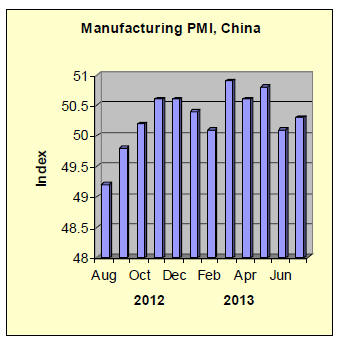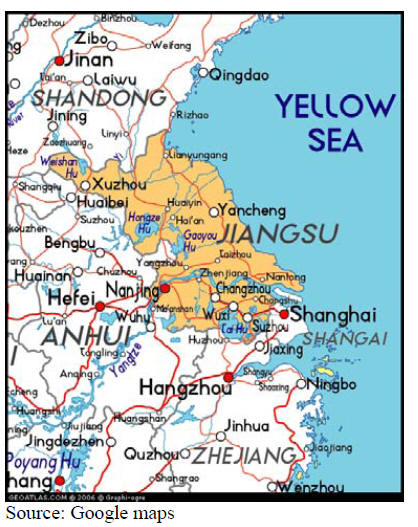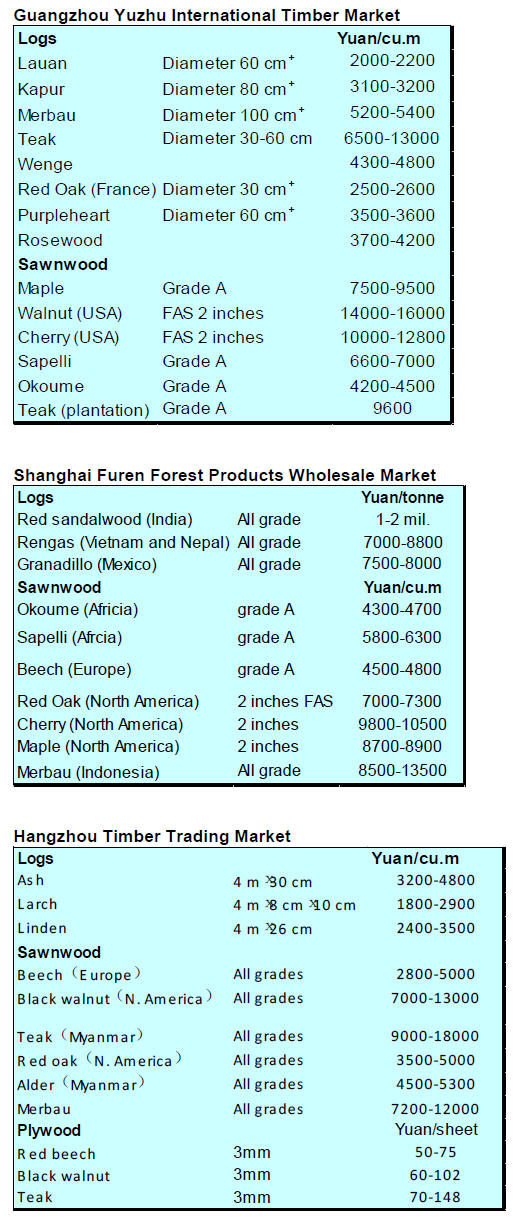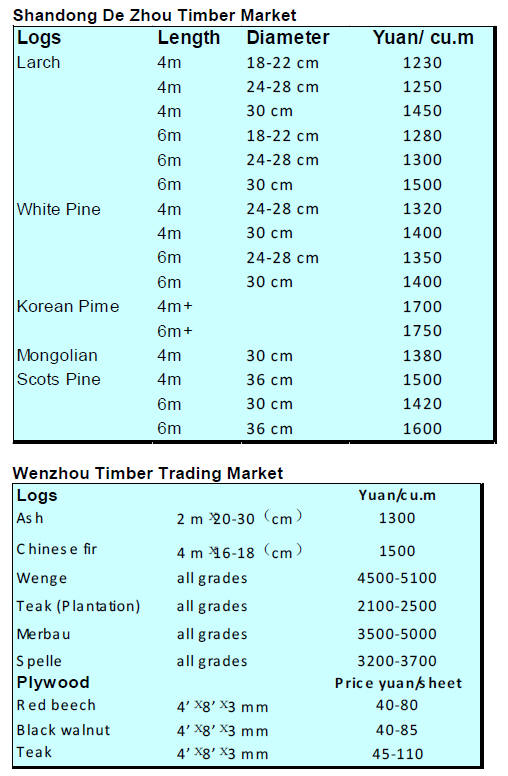US Dollar Exchange Rates of 10th
August 2013
China Yuan 6.1225
Report from China
PMI indicates optimism on part of manufacturers
In July, China's manufacturing purchasing managers index (PMI) was 50.3
percent, up by 0.2 percentage point month-on-month.
The PMI for large-sized enterprises was 50.8 percent, up by 0.4 percent
month-on-month; that of medium-sized enterprises was 49.6 percent, down
by 0.2 percent month-on-month; that of small-sized enterprises was 49.4
percent, up by 0.5 percents month-on-month. In July, of the five
sub-indices constituting PMI, four increased while one declined.

The Production Index was 52.4 percent, up 0.4% month-on-month. The New
Orders Index was 50.6 percent, up 0.2% month-on-month staying above the
negative threshold.
The most recent survey shows that the Export and Import Order Index was
49.0 and 48.4 percent respectively an improvement of 1.3% and 0.5% but
still in negative territory.
The Production and Business Activity Expectation Index was 56.4 percent,
up 2.3 percent over last month, ending a three-month downward trend.
This indicates that the proportion of manufacturing companies that are
optimistic on business activities in the next three months has
increased.
Raw material prices down for seven consecutive weeks
According to the Ministry of Commerce as of the end of June prices of
raw materials used in manufacturing including timber have fallen for the
past seven weeks.
Prices for steel were down 0.4% prices for agricultural materials
dropped 0.1% prices for building materials declined 0.9% of which glass,
timber and cement fell 1.7%, 1.1% and 0.6% respectively.
Too many furniture stores
According to recent estimates, since August 2011 twelve mega home
furnishing stores have closed in China and over the past six months a
further eight large stores have closed.
In addition, another five mega stores are about to relocate. The
closures and relocations are in response to the cooling of the property
development boom which began in 2010.
The China Furniture Association has calculated that for every 10,000
sq.m of furniture store floor area annual sales are in the region of
yuan 100 mil.
Thus, to service domestic furniture demand for yuan 20 bil. (2012
figure) the ideal floor space in the retail sector should be around 20
mil. sq.m. but the total area of current domestic home furnishing stores
exceeds 40 million sq.m.
If the furniture retail sector does not change then 50% of the retail
floor area is likely to be unprofitable.
Obstacle slow development of wood/plastic composite market
Wood plastics composite products are now used more often in China in
construction, interior decoration, outdoor furniture, the automotive and
transportation sectors, logistics and packaging, etc.
However, the biggest problem for further development of the market for
wood/plastic products is inadequate standards and highly variable
product quality which have undermined consumer confidence.
According to the China Institute for Sustainable Development, Wood
Plastic Composite Materials Professional Committee it was not until 2008
that the first national standards were developed.
Following this in early 2009 the national standards ¡°GB/T 24137 wood
plastic decorative panels" and "GB/T 24508 wood plastic flooring" were
prepared and eventually adopted in 2010.
At present another 6 standards for wood plastic composite materials are
either being drafted or awaiting ministerial approval.
First half 2013 good for China's furniture manufacturers
According to the latest data released by National Bureau of Statistics
in the first half of 2013 revenue for furniture manufacturers grew 13%
year on year.
The total accumulated profit in the industry reached yuan15.31 billion,
a year-on-year increase of 16%.
From January to May 2013 the wooden and metal furniture manufacturing
industries contributed most to cumulative profits in the furniture
sector.
Cumulative profits for wooden furniture manufacturers accounted for 60
percent of the total, metal furniture manufacturing industry 26 percent,
other furniture manufacturing industry 10 percent, bamboo, rattan
furniture manufacturing industry 2 percent and plastic furniture
manufacturing 1.8 percent.
Amongst the five sub-sectors growth of profits in the bamboo and rattan
furniture manufacturing industry exceeded 100 percent, plastic furniture
manufacturing 74 percent and wooden furniture 2 percent.
Wood-based panel sales surge
According to the State Forestry Administration (SFA) sales of wood-based
panels have grown by an average of 20% annually since 2007 to reach to
272 million cubic metres in 2012.
However, new policies in the domestic real estate sector and weak
international demand have slowed the expansion of wood based panel
sales.
The SFA estimated that production and sales of China¡¯s wood-based panel
in 2012 were 286 million cubic metres and 272 million cubic metres, up
21 percent and 17 percent respectively.
Jiangsu Province timber imports up twelve percent
The 26 ports in Jiangsu Province handle the highest volume of timber
imports in China. In the first half of 2013 timber imports through ports
in Jiangsu Province achieved a new record of 8.09 million cubic metres
valued at US$1.6 billion, a year on year increase of 12 percent in
volume and value.

Timber imports from North America continue to grow and reached 2.45
million cubic metres in the first half of 2013 making up 30 percent of
the total. Timber imports from Africa fell again and were only 790,500
cubic metres, down 7 percent.
Hardwood log imports from Oceania were stable but softwood imports
increased. Timber imports from New Zealand rose 53 percent to 1.21
million cubic metres. Sawnwood imports through Jiangsu ports declined 17
percent to 853,500 cubic metres in the first half.
ASEAN suppliers drive up imports through Nanhai ports
Statistics from the Nanhai Entry-Exit Inspection and Quarantine
Bureau for January to April show that log imports through Nanhai ports
were worth US$106 million, a year on year increase of 52 percent. It was
reported that as much as 90% of the timber imports were from ASEAN
countries.
The Nanhai international container terminals are in the Sanshan economic
development zone in Foshan city in the mid-northern area of the Pearl
River Delta in the Guangdong Province.
The port is 84 nautical miles from Hong Kong and 70 nautical miles from
Shenzhen. Nanhai port operates seven berths capable of handling both
container and general cargo.
The main reasons for the increase in imports are; first, Nanhai is home
to major furniture and wood product manufacturing enterprises; second,
domestic timber supplies in the area are not adequate to satisfy demand
and finally, timber imports from ASEAN countries duty free.
 
¡¡
|